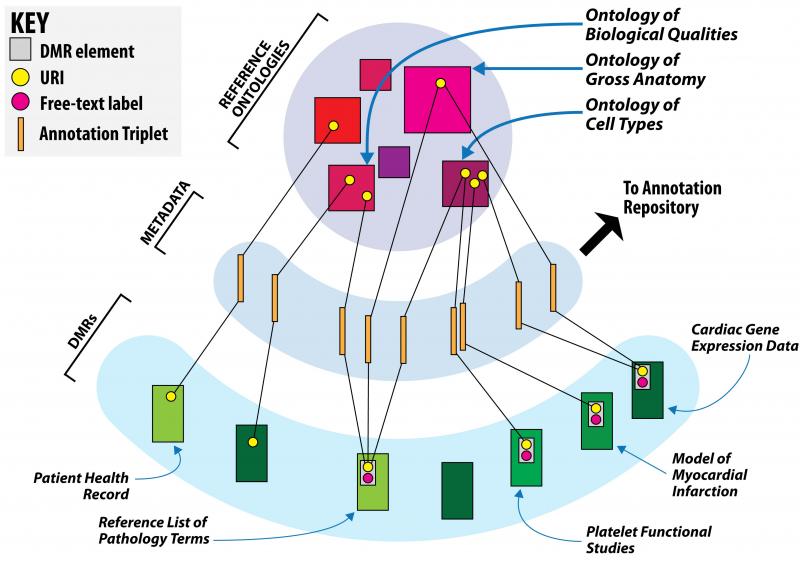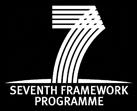Goals
What is the key aim of RICORDO?
The Virtual Physiological Human network represents an active and diverse community of biomedical scientists that studies human biology by computational means. This diversity is the basis for an impressive breadth of scientific approaches, and emergent technologies, as well as potentially shareable resources such as data and models. Although in principle, the resources generated are re-usable, in practice, few can currently be shared. A key reason for this disparity stems from the lack of consistent cataloguing and annotation of VPH data and models (VPHDMs). Another central obstacle involves the lack of a coherent and comprehensive infrastructure that allows distributed VPHDMs to interact with VPH users.
How may these different VPHDMs interoperate feasibly, demonstrably and effectively with one another? The RICORDO project follows a four-point interoperability plan in support of the:
- standardization and harmonization of names and symbols of biological objects;
- use of controlled vocabularies and ontologies to describe (VPHDM) repository content;
- provision of standardized programmatic access to connect distributed repositories with software tools;
- standardization of the minimal information content for different (VPHDM) resource categories as a guide to deposition and information extraction.

Fig. 1 Overall schematic representation of the key aspects of semantic interoperability in which annotations provide a link between data and model (DMR) observations and ontology-based meaning. The above diagram illustrates the role of semantic metadata in support of the semantic interoperability for a set of DMRs. Note that the DMRs may have different formats to encode their scientific content. However, for automated semantic interoperability to be possible between this set of DMRs (bottom layer), the encoding of the semantic metadata content (middle layer) must ideally be in the same language and format. A second key requisite is that the DMR metadata must make use of the same set of reference ontologies for its semantic content (top layer).
To this end, RICORDO was formed to provide a metadata framework that employs high quality annotation quality standards, unifying names and symbols of biological objects, allowing for the representation of multiscale biological entities represented across VPHDMs. Such a task will require the provision of a communal annotation and repository communication strategy that allows for the integration and interoperability of data and knowledge within the VPH domain. RICORDO will also also provide a standard annotation scheme for the VPH community that will enable annotation of models and data. The scheme will either extend current standards (such as MIRIAM) or provide a set of qualifiers to represent the relationships between model element and their annotations.
In addition, RICORDO will provide the infrastructure to query and retrieve VPHDMs. This effort will provide a centralized RDF store containing annotations, allowing of for speedy and advanced querying of the data. Storing the data in RDF and related KRs such as OWL will also support complex ontology-based querying. SPARQL, a query language for RDF, will be used to querying the RDF data store.
RICORDO will, furthermore, assist the VPH community by:
- designing the annotation pipeline and actively participating in its wide application;
- co-ordinating a term request service with the relevant ontology groups to add missing terms required for annotation by the VPH community;
- researching a communal grammar for post-co-ordinated expressions with which to annotate VPHDMs. These composite constructs will combine terms originating from different ontologies in a systematic and consistent manner across all VPH resources;
- contributing a VPHDM interoperability plan to the VPH NoE’s Toolkit Development and the Standards & Data Working Groups ;
- designing and prototyping a RICORDO Infrastructure that will support efficient RICORDO ID-based queries across distributed VPHDM services;
- piloting the VPHDM multiscale interoperability plan and distributed repositories by carrying out demonstrator projects at a molecular, organ and systems level;
- disseminating the resultant methodologies and building a support and training network for the implementation and further development of the CORDO strategy.
In particular, the pilot projects discussed in above aim to demonstrate the effectiveness of the RICORDO framework across three fundamental medical scenarios, and to show how a well defined and curated ID space is essential in the:
- interpretation of Genome-Wide Association Study results;
- use of statistical radiological models to provide patient-specific parameters to volumetric modelling environments, and
- annotation of SBML and CellML physiology model variables for the integration of pharmacological and gene expression data.
A more detailed description of the RICORDO project plan is available at this link: Description of Work.


